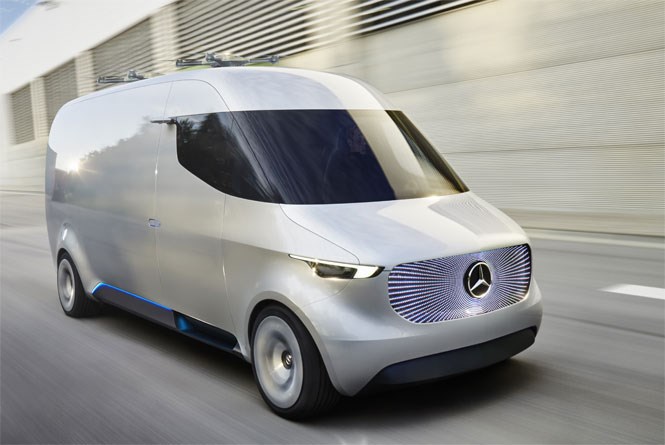Mercedes-Benz Vans is displaying its futuristic Vision Van concept at CES 2017 – the first time Mercedes’ light commercial vehicle arm has attended the world-famous Consumer Electronics Show.
The Las Vegas event, which happens every January, has traditionally focused on gadgets such as smartphones. But in recent years the car industry has increasingly started to use CES to showcase next-generation technology.
In this respect the Vision Van – which was first unveiled in Germany in September 2016 – is the perfect vehicle to mark Mercedes Vans’ debut. It’s packed with tech designed to make the lives of near-future parcel couriers much easier.
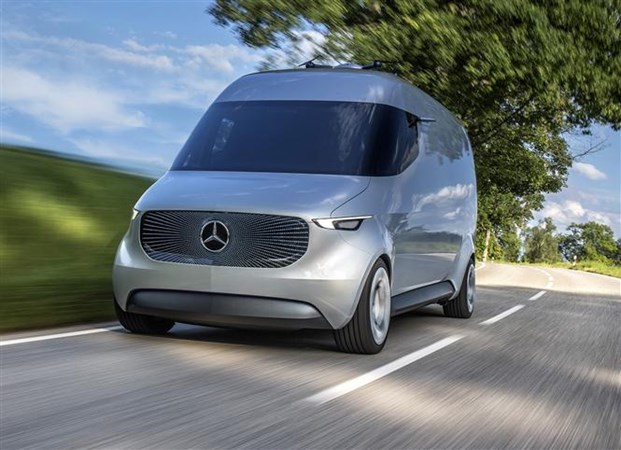
From the drones on the roof and the fully automated racking system to the all-electric drivetrain, this could well be the most revolutionary van concept we’ve ever seen. And you can recap our full story on the van below.
Mercedes isn’t the only van manufacturer attending CES in 2017, however. Ford has also taken the opportunity to announce a new plug-in hybrid version of the Transit Custom – click here to read that story.
What is the Mercedes Vision Van concept?
Mercedes-Benz Vans has been gazing into a crystal ball and come up with this all-electric Vision Van concept as a preview of what we can expect from innovation in the light commercial vehicle sector in the not-too-distant future.
The Vision Van is first and foremost an attention-grabbing exploration of the idea of fully connected ‘smart’ vans, which are coming soon to join the ‘internet of things’ and make your business more efficient.
But at first sight you’re probably going to have trouble getting beyond the funky looks and the fact that it has a pair of drones parked on the roof…
Yes. Drones first, smart van connectivity second. What’s going on here?
Obvious, really. Traffic is getting worse, delivery demands are getting ever more specific – same day is swiftly becoming same hour – and making sure the customer gets what they want, when they want it is requiring increasingly innovative solutions. So why not dodge the traffic altogether and fly the package the last mile to the customer’s door?
That’s exactly what the drones on the Vision Van are for – though away from the world of concepts, Mercedes is currently working more seriously on the idea of drones being used to deliver the goods from the wholesaler to the van, rather than from the van to the end customer. Either way, the van is rapidly becoming a mobile hub, rather than a simple method of transportation.
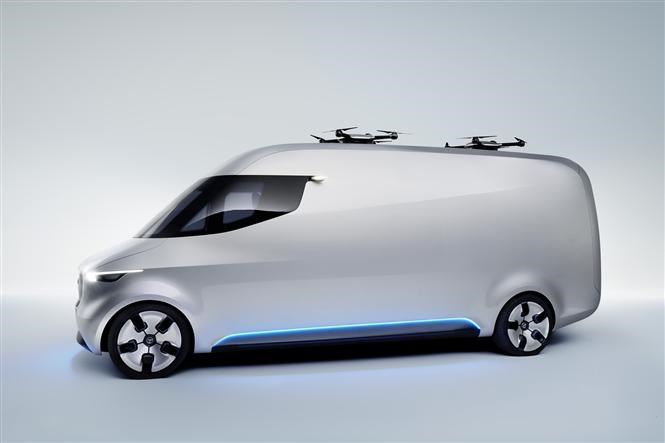
Whatever happens in the future, it’s unlikely drones will actually fly right up to your door – instead they will use designated landing places, and adhere to an autonomous flight control system that’s apparently already in the planning stages in the USA, complete with involvement from NASA. No kidding.
The drones Mercedes is using come from a company called Matternet, can carry up to 2kg and travel up to 12 miles on a single charge at speeds of up to 37mph. The battery is replaced every time a new package is loaded.
How do the packages get to the drones? Can’t help noticing the Vision Van doesn’t have any side doors?
Helping the drones out, the load-space inside the Mercedes Vision Van is fully automated as well.

Prior to departure, the goods are sorted into special carriers; in turn these are loaded into racks, which are then slotted into the van via the top-opening tailgate using autonomous rack-feeder machines – in what’s called a ‘one-shot loading’ process.
Once onboard, an internal mechanism a bit like a fancy vending machine picks the goods on approach to destination, and serves them up to the drones on the roof via hatches underneath them to do the final delivery.
The driver won’t even have to step out of the van – although the system can hand goods off to them as well. Either way, the procedure takes just 30 seconds, compared to the minutes it might usually take trying to find the right package for the right person.
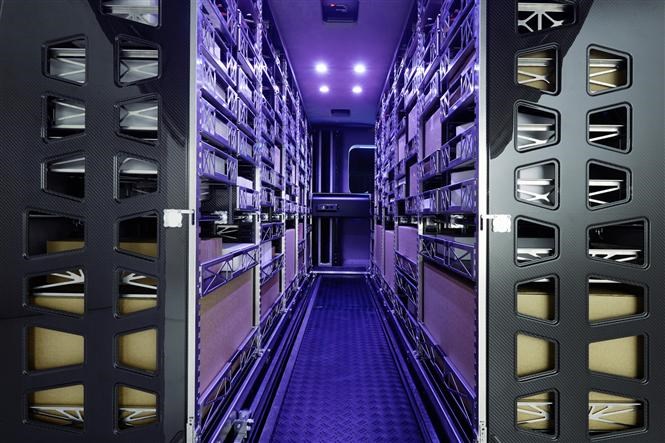
This might sound crazy, but Mercedes is already working on a loading system based on these principles called Slider.
The Vision Van is electric, is it?
Of course it is. Everything is going to be run on batteries soon – including a new production electric van that Mercedes announced at the 2016 IAA Commercial Vehicle Show last September.
Going back to fantasy land for a moment, the Vision Van concept is powered by a 75kW electric motor – that’s approximately 102hp – and carries enough batteries under the load area to cover between 50 and 168 miles, depending on configuration and usage. Mercedes has calculated that inner-city couriers likely to use this technology generally travel around 25 miles per shift.

And if 102hp doesn’t sound like a lot, don’t worry – the system can double its output to 204hp for 60-second bursts, delivering up to 270Nm of torque in the process. Top speed is theoretically 75mph, but the Vision Van is limited to 50mph, a speed that Mercedes describes as “adequate” for its tasks.
Why should I care about it being electric?
A number of reasons. Mercedes believes that electric vans will shortly offer a lower total cost of ownership than conventional vans – obviously depending on the usage case. But perhaps more significantly, they produce zero CO2 emissions in motion, so will have access to low-emission zones, the numbers of which are only likely to increase in the future.
They’re also virtually silent – which opens up new business models for late-night delivery services in sound-sensitive residential areas.
Why does the Vision Van look so funny?
Surprisingly, Mercedes hasn’t made much of a fuss about aerodynamics, but details such as replacing the door mirrors with cameras will certainly help in this regard (as well as placing these easily damaged items well out of the way of aggressive cyclists). It has, however, said we can expect to see the general design of the Vision influencing its future van production models.
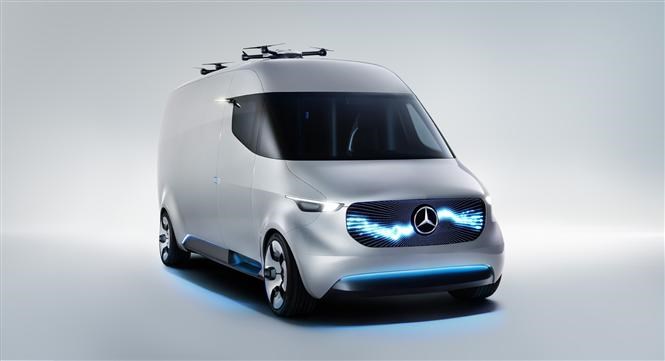
While this may well be true of the slimline LED headlights, we can’t quite see the grille making it into the showroom any time soon. This is actually a giant LED Matrix, which uses 500 rows of 2,000 LEDs to display information to surrounding road users and pedestrians, such as a warning that a drone is about to take off or land, for example, or even letting oncoming traffic know that there’s a cyclist crossing behind the van.
Brilliant, right up until that point you misjudge the entry to the yard or someone rear-ends you on the M25, and the cost of replacement reveals itself…
Is it just as wacky on the inside?
Wackier. Instead of a steering wheel there’s a joystick (an idea they stopped using on car concepts in about 1983) and the dashboard is one large arc, packed with integrated information displays, including the conventional instruments. All of these remain hidden until needed.
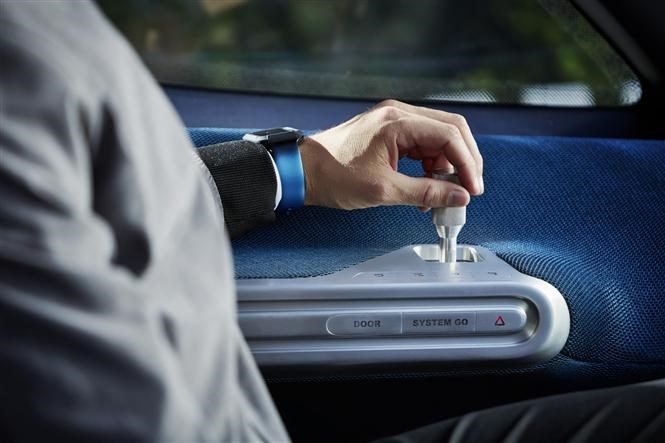
Just in case this wasn’t weird enough, Mercedes has built lights into the stainless steel floor, in an effort to help the driver spot approaching pedestrians or cyclists. And on the back wall of the cab there’s a screen displaying delivery data, alongside a package dispensor that saves the driver from ever having to go into the load compartment; this is fed by the same system that loads the drones on the roof.
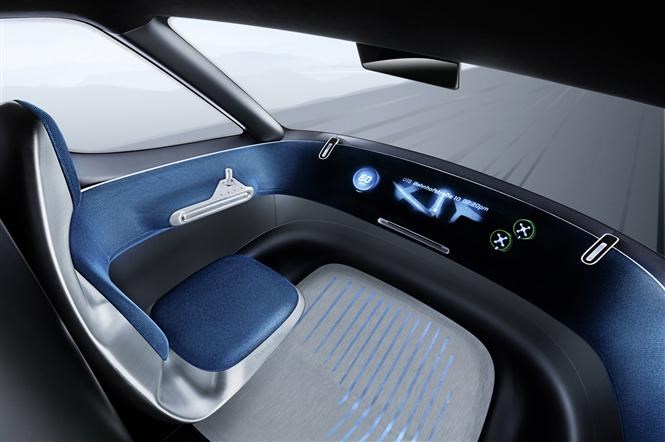
On a more serious note, the Vision Van does show the potential advantages of an electric drive system when it comes to passenger and cargo space. With no conventional engine and gearbox to accomodate, the driver can be closer to the front of the vehicle, the load area can be longer, and the vehicle floor made totally flat.
What about this connected smart van business?
A brave new world of apps is about to descend upon us – designed to help both drivers and fleet managers operate more efficiently. This will integrate the van into the so-called internet of things, where everything is connected, all of the time.
Not only is Mercedes envisioning a near future where computer systems track vehicles, optimise delivery routes and teach you how to drive more efficiently, this always-online ‘cloud’ technology will shortly start to deploy algorithms to control the picking order of goods, the loading process and the aforementioned fully automated cargo space management.
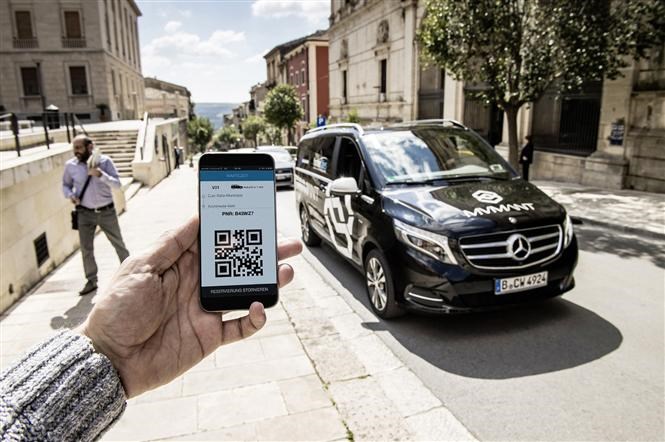
This might sound far-fetched, but it’s the least sci-fi element of the entire concept. A computer will soon be telling you the best route to take and coaching you on your driving while you follow its instruction, but more than that, it will also be organising your load for you and helping you find the right item as quickly as possible once the destination is reached.
Stefan Mauer, head of the Future Transportation Systems Department at Mercedes-Benz Vans:
‘I am convinced that we will develop many other ground-breaking holistic system solutions on the basis of this concept for an intelligent and fully interconnected van. The Vision Van is not the end of a project – it marks only the beginning.’
Just so you know, we may receive a commission or other compensation from the links on this website - read why you should trust us.


